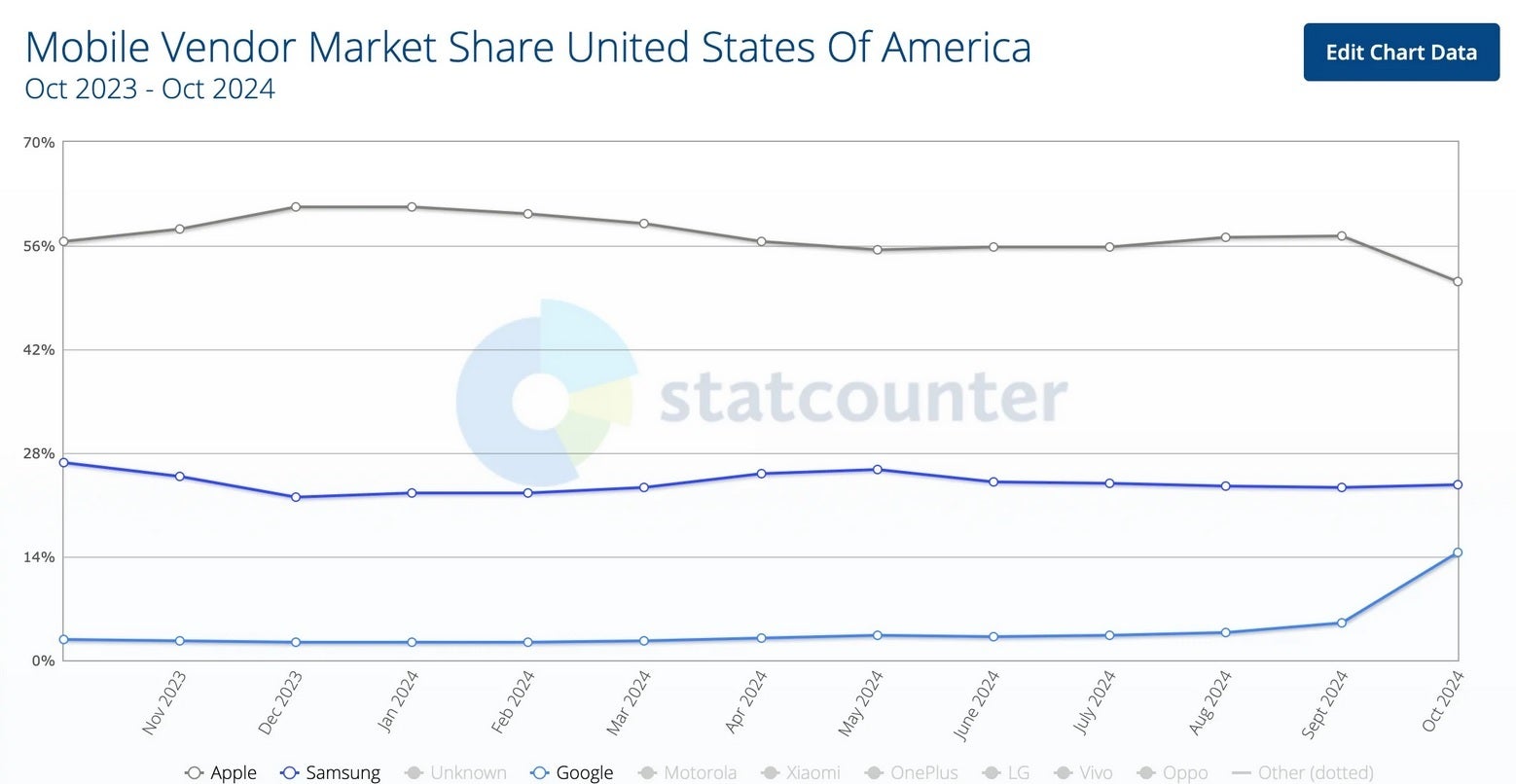Chart shows that the Pixel 9 series grabbed U.S. market share from the iPhone

A graph posted online by statcounter shows an interesting trend in the market shares of three major phone manufacturers in the U.S. that started taking shape in September 2024. Around that time, Apple saw a marked decline in the U.S. market share of the iPhone. The decline continued through the end of October which is interesting since that time period includes the September 20th release of the new iPhone 16 series.
The top line of the chart shows Apple's U.S. market share over the last 12 months. The middle line represents Samsung's market share in the country, while the third line shows us the Pixel's U.S. share for the last year. Apple and Samsung are the top two smartphone vendors in the States. Google is third with Motorola fourth,
Pixel started gaining market share in the U.S. at the same time that iPhone was losing market share
But what is even more interesting, and exciting for Google and Pixel fans, is the sharp hike in Pixel market share at the same time that the iPhone started losing ground in the States. This can be easily spotted in the statcounter chart. At the beginning of September, the Pixel 9 line had been out for slightly more than a week and the strong increase in market share continued throughout October.

The U.S. market share of the Pixel, at bottom, gained on Apple, at the top, in September and October. | Image credit-statcounter
Last week, Google parent Alphabet released its third-quarter earnings, and the category titled "Google subscriptions, platforms, and devices" showed a strong 29% year-over-year gain in revenue. Considering that this is the category that includes the Pixel 9 series, this increase would suggest that Pixel 9 series demand was strong. And the statcounter graph seems to dovetail with the earnings report.
So Pixel's U.S. market share rises at the same time that the iPhone's U.S. share starts to decline. One could reach the conclusion that the strength in Pixel demand was responsible for the weakness in the demand for the iPhone in the U.S. from September through October.
The statcounter graph includes the U.S. market share of one other phone manufacturer, Samsung. While the iPhone lost market share in the U.S. during September and October, and the Pixel's market share rose during those two months, Samsung has held a pretty stable slice of the U.S. smartphone pie ever since the beginning of this year. Even during September and October, when the Pixel 9 was adding market share and the iPhone was losing share, Samsung's share stayed remarkably consistent.
Pixel 9 Pro XL was one of the top ten premium phones in the U.S. during Q3
According to Counterpoint Research, the Pixel 9 Pro XL was one of the top ten premium phones sold in the U.S. during the third quarter of 2024. Premium phones are those that carry a retail price tag of $800 or higher. Overall, Google accounted for 4% of all phones shipped to U.S. distributors during Q3 which happens to be a third quarter record for the Pixel line.
You might expect the strength of the Android-powered Pixel in the U.S. to harm the market share of popular Android manufacturer Samsung in the country. Instead, over the previous two months, the strength of the Pixel 9 line in the U.S. resulted in weaker iPhone demand. Make no mistake about it, Pixel sales trail both Apple and Samsung by a large margin in the U.S., but Google closed the huge gap during the last two months.
Google has a long way to go to be competitive with Apple and Samsung, but next year the Pixel 10 series will be powered by a new Tensor G5 application processor built by Google from the ground up which means no more Exynos foundation. The chipset will also be built on TSMC's 3nm node giving Google the opportunity to improve the performance and energy efficiency of the 2025 Pixel series and keep the momentum going.
Follow us on Google News












Things that are NOT allowed:
To help keep our community safe and free from spam, we apply temporary limits to newly created accounts: